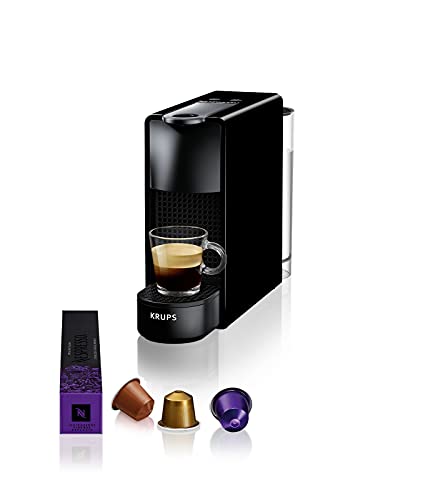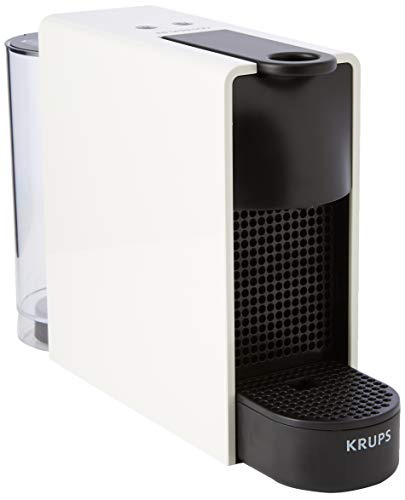Nespresso Coffee – The Essenza Mini
 The Essenza Mini is compact and affordable. It’s also simple to use. It doesn’t have features like the water tank and drip tray that can be removed to remain small, but it makes excellent espresso and lungo.
The Essenza Mini is compact and affordable. It’s also simple to use. It doesn’t have features like the water tank and drip tray that can be removed to remain small, but it makes excellent espresso and lungo.
 It works by piercing capsules and pumping hot water under pressure to make various espresso drinks and coffee sizes, like the 1.35-ounce espresso, 2.7-ounce double espresso, 5-ounce gran lungo or 14-ounce alto. It can be used in conjunction with an independent milk frother.
It works by piercing capsules and pumping hot water under pressure to make various espresso drinks and coffee sizes, like the 1.35-ounce espresso, 2.7-ounce double espresso, 5-ounce gran lungo or 14-ounce alto. It can be used in conjunction with an independent milk frother.
Capsules
The Nespresso system lets you brew coffee at the touch of a button. You can choose between a single-serving cup or a larger one, and each capsule is filled with the correct amount of coffee beans to give you the strength you want. You can also add milk powder for a cappuccino or macchiato latte. The capsules are made of biodegradable and non-toxic materials that can be recycled or disposed in a way that is guilt-free.
The pods are constructed of aluminum and are able to withstand the high pressure of the machine. The pods are sealed and can’t be tampered with. The coffee grounds remain fresh, shielded from oxygen and moisture. In addition, the aluminium is completely recyclable, which aligns with Nestle’s sustainability objectives.
However this system isn’t without its flaws. First of all the machines are costly to purchase and operate. The capsules are also expensive to purchase and must be replaced regularly. The machines can also only be used with capsules branded Nespresso. This has led to a variety of lawsuits between Nestle and third-party companies that use the same extraction method and ingredients as Nespresso.
Despite these drawbacks, the Nespresso system has many benefits, including high-quality coffee and sustainability for the environment. It’s a great alternative to regular coffee and tea bags, and it comes with a much higher extraction rate than other single-serve systems. A single capsule can yield up to 14 ounces of espresso coffee.
The first capsule was created in 1976 and was patented in 1978. Its most important features are an cone of aluminum foil, a flat top with a cylindrical recess into which the machine injects hot water, and a narrow opening inside the base, which is punctured both above and below. The capsule spins at 7000 rpm by the machine to inject water into the coffee to create a thick creamy crema.
Water
When you use a Nespresso machine, it’s essential to use high-quality water. This is crucial to ensure consistency, as well as flavor and texture. You should use “filtered” water or “spring water,” and avoid tap water or distilled water.
In our lab tests we found that machines with softened water produce more delicious espressos and lungos than those with hard water. Hard water can cause calcium deposits, as well as other problems which will alter the taste of your coffee.
In each cup of coffee The Nespresso machine infuses and then pumps out hot water at high pressure. This process is known as extraction. The duration, temperature and pressure of the extraction process is the factors that determine the flavor and strength of your coffee.
The original machines are pierced and then pump the capsule, while the Vertuo models read barcodes on the capsules in order to determine how much water is needed for a particular type of espresso. The Vertuo models can brew six different drink sizes, including espressos and lungos with or without caps of foam.
All of the machines in the Nespresso range can provide 19 bars of pressure. Some of the more expensive models can also brew cappuccinos as well as latte macchiatos and some models even provide the option to make iced coffee.
Inissia machines and U-series machines are small which makes it easy to fit them in tight areas. The Nespresso Pixie, which has a built-in frother, is a different compact option. It can also be integrated with the nespresso pop machine app to access custom recipes and order capsules. Nespresso is an excellent choice for those looking to reduce their footprint on the environment while also contributing to the company’s sustainability initiatives.
Temperature
Nespresso machines are more sophisticated than your typical coffee maker, but they are also designed to be speedy and easy to use. They work very quickly, taking just an hour to prepare each capsule. They are also energy efficient. Unlike traditional drip coffee makers which consume more power per cup of coffee, nespresso Coffeee Machine machines only use just a tiny amount of power to brew each capsule.
The majority of Nespresso coffee machines are designed for drinks based on espresso, but certain models come with a milk frother that can be used to make cappuccinos and lattes. Some models come with a capsule container that can hold up to 12 empty capsules at a time which makes them simple to recycle.
The Nespresso brand is supported by several well-known kitchen appliance manufacturers, such as Krups delonghi nespresso machine, and Breville. The majority of machines are produced by Eugster/Frismag which is which is a Swiss company which is one of world’s biggest coffee machine manufacturers. This has led to criticism of the company’s use of patents and other strategies similar like those employed by printer makers to create lock-ins for vendors.
Pressure
To get the best espresso you should keep the same pressure throughout your extraction. This is referred to as “pressure profiling.” Pressure profiling is the process of altering the amount of pressure that is applied to the coffee grounds to achieve an optimal extraction and enhance the flavor. This technique can be achieved through the use of various espresso machines, including Nespresso coffee makers.
There are several ways espresso machines can control the pressure during extraction. A balanced bypass keeps the water pressure at a fixed number, usually 9 bars regardless of the inlet. This is a simple, efficient technique that guarantees that all espresso groups have the same pressure throughout the extraction process.
Another option is to manually adjust the pressure with the lever or control knob. This method is more difficult but it offers an increased degree of personalization and control. It is important to note that manual pressure regulation could result in inconsistent results, which is why it requires a lot of skill and attention.
In addition, certain espresso machines utilize a dynamic pump that adjusts the pressure according to the temperature of the grounds and Nespresso Coffeee Machine the type of coffee being used. This is a more sophisticated system, however it will provide more consistent results than other types of espresso machines.
Nespresso offers a range of machines that can create espresso and lungo drinks, and others that can also make milk froth. The Nespresso Inissia makes a great machine for baristas at home. It can make 7 to 9 espressos at a time and has a water tank of 33 ounces. It has buttons that allow you to choose various sizes of drinks, and a capsule tray that can hold up to nine pods. The Nespresso Vertuo Next is designed for versatility and features a range of 11 milk temperatures and eight milk textures to select from. It also comes with a huge stainless steel milk frother wand and an insulated container that can hold up to 18 ounces of capsules that have been used.
Cleaning
If you use a Nespresso machine, it leaves behind small mineral and limescale residues each time you make your cup. These residues can mix with your coffee, which can cause it to taste bad. It is crucial to clean your Nespresso machine regularly and all its components. A deep clean should include descaling and washing the removable parts, like the drip tray and capsule container. A daily wash of the capsule container with clean water will also help to stop the buildup of mineral.
Using a de-scaling solution can help eliminate mineral deposits from your machine. You can find these products in most appliance and coffee stores. You can also use vinegar. This versatile cleaner won’t harm your machine, but it might take longer for the minerals to dissolve than a descaling solution.
If you decide to use vinegar, first take out the coffee pods and empty the reservoir of water. Then, pour out the remaining water from the tank, as well as any built-in water filters. Pour into the vinegar and run a brew cycle without coffee pods so that it can flow through the machine. Then, wash with clean water and run a few additional cycles to ensure that there are no traces of vinegar remaining in the machine.
After cleaning your machine, you can clean the exterior and the removable parts. Pay special attention to crevices and corners where gunk may get caught. You can clean the parts that are removable with mild soap in your dishwasher, or by hand. Rinse them thoroughly. You should also inspect the seals around your capsule and coffee outlet, and replace them as needed to maintain their elasticity and prevent leaks.
